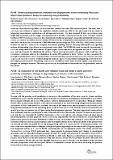Por favor, use este identificador para citar o enlazar a este item:
http://hdl.handle.net/10261/209140COMPARTIR / EXPORTAR:
 SHARE
BASE SHARE
BASE
|
|
| Visualizar otros formatos: MARC | Dublin Core | RDF | ORE | MODS | METS | DIDL | DATACITE | |

| Título: | Co-inoculation of rice plants with nitrogen-fixing and indole-3-acetic acid (IAA)-producing endophytes: changes in physiological parameters of the host plant |
Autor: | Andreozzi, Anna; Prieto, Pilar CSIC ORCID ; Mercado-Blanco, Jesús CSIC ORCID ; Monaco, Stefano; Zampieri, Elisa; Romano, Silvia; Valè, Giampiero; Defez, Roberto; Bianco, Carmen | Fecha de publicación: | dic-2019 | Citación: | International Symposium Microbe-assisted Crop Production (2019) | Resumen: | To cope with the growing world population an increase in the production of the main crops for human nutrition, including rice, is now urgently needed. To achieve this goal, the expensive and polluting chemical fertilizers have already been overused. Nitrogen (N) is one of the primary nutrients limiting plant growth in agriculture. Biological nitrogen fixation (BNF) by diazotrophic bacteria, which reduce atmospheric N to ammonium using nitrogenase enzyme systems, accounts for 30-50% of the total N in crop fields. The area of BNF research has been expanded by the discovery of N-fixing bacterial endophytes in non-nodulating plants. In the last few years a wide diversity of bacteria associated with cereals have shown to possess the nifH gene coding for dinitrogenase reductase. This gene is genetically conserved and thus traditionally used as a marker gene to study the genetic diversity of diazotrophs in nature. To improve plant growth and yield the use of genetically modified diazotrophs or the co-inoculation with nitrogen-fixing and plant growth promoting bacteria has been proposed. We have previously reported that the strain Enterobacter cloacae RCA25-64, engineered to produce and release 36-fold more indole-3-acetic acid (IAA) than the wild type E. cloacae RCA25, showed increased nifH gene expression and nitrogenase activity in liquid cultures and inoculated rice plants. In the present study we analysed the effect of purified IAA on the nitrogen-fixing ability of E. cloacae RCA25. Co-inoculation studies were also carried out to test the ability of different wild type IAA-producing endophytes to enhance the nifH gene expression and nitrogenase activity in E. cloacae RCA25, preventing the use of engineered strains. Our results showed that Herbaspirillum huttiense RCA24 performed best. Improvements in nitrogen-fixation and changes in physiological parameters such as chlorophyll, nitrogen content and shoot dry weight were observed for rice plants (Oryza sativa L. cv. Baldo) co-inoculated with strains RCA25 and RCA24 in a 10:1 ratio. Based on confocal laser scanning microscopy analysis, strain RCA24 was the best colonizer of the root interior and the only IAA producer located in the same root niche occupied by RCA25 cells. Our data highlight that the assessment of location and distribution of the individual microbial components within the host plant tissues is fundamental to select bio-inoculants containing IAA-producer strains able to enhance nitrogen-fixation. | Descripción: | Trabajo presentado en el International Symposium Microbe-assisted Crop Production (miCROPe 2019, Opportunites, Challenges and Needs), celebrado en Viena del 2 al 5 de diciembre de 2019. | URI: | http://hdl.handle.net/10261/209140 |
| Aparece en las colecciones: | (IAS) Comunicaciones congresos |
Ficheros en este ítem:
| Fichero | Descripción | Tamaño | Formato | |
|---|---|---|---|---|
| host_plant.pdf | 251,98 kB | Adobe PDF |  Visualizar/Abrir |
CORE Recommender
Page view(s)
161
checked on 24-abr-2024
Download(s)
81
checked on 24-abr-2024
Google ScholarTM
Check
NOTA: Los ítems de Digital.CSIC están protegidos por copyright, con todos los derechos reservados, a menos que se indique lo contrario.
